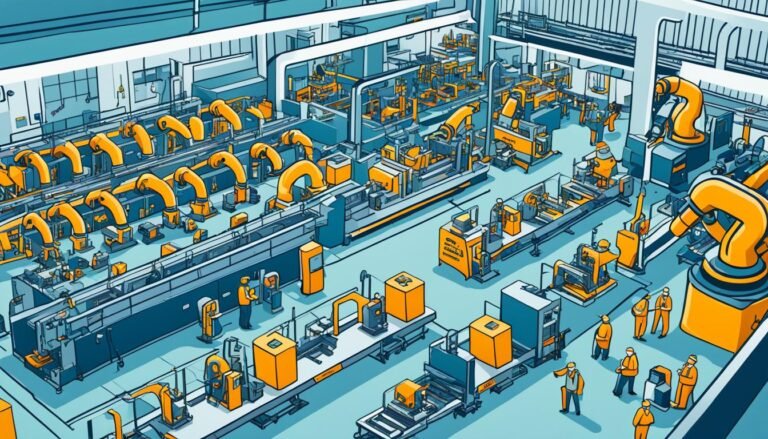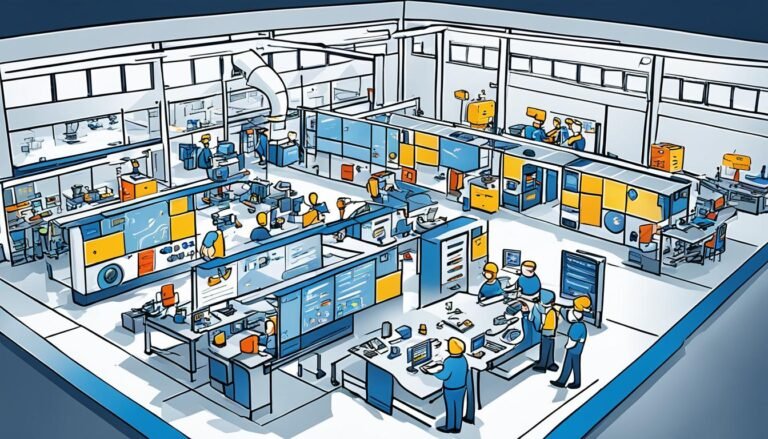Change Management in Manufacturing
Did you know that 58% of manufacturing companies struggle with technology changes because of high initial costs? This fact shows how vital effective change management is in the manufacturing world. As markets change, companies must keep up to stay ahead. A strong change management plan is key to success.
Manufacturing faces many challenges, like supply chain issues from COVID-19 and economic ups and downs. The Great Resignation has also changed the workforce, making it hard to bring new employees up to speed. To stay competitive, companies are investing in change management programs. These programs help them adapt quickly and efficiently.
Good change management is more than just recognizing the need for change. It requires careful planning, support from leaders, and clear talks with employees. It helps move from old ways to new, improving efficiency and making room for innovation. Without it, companies might see lower productivity, unhappy workers, and unhappy customers.
Key Takeaways
- 58% of manufacturing entities face challenges with technology changes.
- Supply chain disruptions and economic uncertainty intensify the need for change management.
- The Great Resignation has reshaped the manufacturing workforce, complicating employee onboarding.
- Strong change management helps future-proof manufacturing operations.
- Absence of effective change management can lead to reduced productivity and customer satisfaction.
- Digitization and real-time data analysis are critical in modern change management strategies.
- Investing in skill development is crucial as the industry evolves.
What is Change Management in Manufacturing?
Change management in manufacturing is a way to make changes smoothly. It aims to improve efficiency and streamline operations. Product Lifecycle Management (PLM) is key to making sure products meet business goals from start to finish.
Understanding the Basics
Small to mid-size manufacturers use strong processes to get products to market fast. Successful change management means spotting problems early and fixing them quickly. It uses documents like Manufacturing Change Requests (MCRs) and Manufacturing Change Orders (MCOs) to detail changes.
Building good relationships between engineering and manufacturing teams helps too. This makes the change process smoother.
Key Benefits in Manufacturing Environments
Effective change management in manufacturing has big benefits. It makes operations more efficient, cuts waste, and helps follow rules better. Quick changes help companies meet market needs fast.
Using electronic tools speeds up the review and approval of changes. This means changes happen faster and with fewer delays.
| Benefits | Impact |
|---|---|
| Operational Efficiency | Streamlined production and reduced time to market |
| Waste Reduction | Minimized resource wastage, optimized costs |
| Compliance Adherence | Improved regulatory alignment and certification |
Challenges and Opportunities
Dealing with market changes and quick demand shifts is tough in change management. But, these challenges also bring chances for new ideas and better processes. Using new tech and PLM systems can help a manufacturer stay ahead.
Encouraging open talk and getting employees involved early can reduce resistance. This makes change efforts more likely to succeed.
The Importance of Digital Transformation in Change Management
In today’s fast-changing manufacturing world, Digital Transformation is key for managing change well. It uses modern tech to make processes smoother, improve communication, and guide decisions with data. This part looks at how digitization, predictive analytics, and automation change how we manage change.
Role of Digitization
Digitization is now central to managing change in manufacturing. It helps use data to make smart choices. Forrester’s 2022 survey found 21% of global services leaders struggle with adding new processes and skills. By going digital, companies can collect data in real-time, cut down on mistakes, and work better.
| Challenges | Solutions |
|---|---|
| Implementation of new processes | Digitization for real-time monitoring |
| Lack of employee support | Effective communication through digital platforms |
| Unclear objectives | Data-driven strategies |
Predictive Analytics for Decision Making
Predictive analytics changes the game in managing change. It uses data to see trends, predict problems, and make better decisions. This helps leaders tackle issues early, cut downtime, and keep changes in line with business goals. Middle managers play a big role in putting these insights into action in their teams.
Automation of Change Processes
Automating change processes is a big part of Digital Transformation. It cuts down on mistakes, speeds up work, and keeps things consistent. For example, most IT leaders now focus on Digital Transformation. By automating routine tasks, companies can spend more time on strategy and innovation. Good leaders listen more and talk less during changes, creating a culture that sees change as a skill to improve, not a problem to avoid.
Lean Manufacturing and Change Management
Lean manufacturing and change management work well together by cutting waste and adding value. For success, strong leadership and a culture of ongoing improvement are key. The World Economic Forum says over 70% of companies using Industry 4.0 tech don’t move past the pilot stage. This shows the importance of a well-planned and flexible change process.
Starting lean manufacturing changes means big shifts in how the company is structured, its strategy, and its tech. Leadership and management are key to pushing these changes. They need to be supported by good communication, team growth, a culture ready for change, and empowering employees. Research on Malaysian car part makers shows that being ready for change and strong leadership are key to success.
Many lean manufacturing projects fail during the start, even if the goals are good. A Daily Management System (DMS) can help plan and manage changes well in a company. This system helps set and track key performance indicators (KPIs) that match lean goals. It’s important to document and standardize best practices from these lean efforts to avoid future failures.
| Success Factors | Description |
|---|---|
| Leadership and Management Commitment | Crucial for driving change and maintaining momentum in lean manufacturing. |
| Effective Communication | Ensures all stakeholders are informed and aligned with the change process. |
| Team Development | Focuses on building a strong, cohesive team to champion lean initiatives. |
| Cultural Readiness | Prepares and aligns the organizational culture with lean principles. |
| Employee Autonomy | Empowers employees to take initiative and drive continuous improvement. |
Lean manufacturing means making and improving processes in different areas. This includes process, function, coordination, values, human behavior, and organizational power. Leadership is key in making these changes happen and keeping the company focused on continuous improvement.
Key Steps in the Manufacturing Change Management Process
Mastering change management in manufacturing leads to smoother transitions and successful changes. Key steps include Manufacturing Change Requests, Manufacturing Change Orders, and thorough documentation. These are paired with strong communication strategies.
Manufacturing Change Request (MCR)
The Manufacturing Change Request is the first step in managing changes. It’s a formal proposal for changes in materials, processes, or product designs. This request is carefully checked to see its impact and if it’s possible, ensuring decisions are based on solid data.
- Ensures comprehensive evaluation of proposed changes.
- Facilitates analysis of potential risks and benefits.
- Promotes efficient change propagation within manufacturing processes.
Manufacturing Change Order (MCO)
After approving an MCR, the Manufacturing Change Order is issued. The MCO outlines the steps to put the approved changes into action. It’s key in making sure changes are done quickly and right, without disrupting production.
- Acts as a roadmap for the implementation of changes.
- Maximizes efficiency by clearly defining roles and responsibilities.
- Assures adherence to quality standards and timelines.
Documentation and Communication
Good documentation and communication are vital for successful change management. Precise documentation tracks changes and aligns project goals and resources. It also helps evaluate risks. Strong communication between departments fosters teamwork and smooth transitions.
| Importance | Advantages |
|---|---|
| Documentation | Keeps a detailed record of changes and decisions. Facilitates training and knowledge transfer. |
| Communication | Ensures consistent information flow. Encourages stakeholder engagement and adoption. |
In conclusion, focusing on these key areas helps manufacturers adapt to market changes efficiently. This leads to better productivity and innovation. Companies that excel in these areas often stay ahead in the fast-changing manufacturing world.
Agile Methodologies in Change Management
Agile methodologies help manufacturers quickly adapt to change. They focus on being flexible and aim for better operational results. A study found five common challenges in adding change management to Agile projects. These include not valuing change management, resistance from the organization, and managing changes step by step.
For Agile change management to work, it must blend strategic planning with day-to-day actions. Getting everyone from top leaders to workers on board is key. Success comes from early involvement of change managers, steady updates, and leaders supporting the change. Celebrating small victories also keeps everyone motivated.
Getting everyone involved in the Agile change process is crucial. This means adding change management tasks to the project plan and making sure the Scrum Master focuses on it. It’s also important to work together as a team and talk often with employees. Agile isn’t just for software; it’s about making all areas of a company work better together.
| Importance | Key Activities |
|---|---|
| Engagement | Early involvement of change managers. |
| Operational Excellence | Regularly celebrating early wins. |
| Collaboration | Integrating change management tasks into Agile sprints. |
| Flexibility | Adjusting project scope and priorities dynamically. |
Agile projects are broken into short sprints, usually 1-4 weeks. Creating a plan to help everyone accept change is part of Agile change management. In each sprint, important tasks must be done. Agile’s flexibility lets projects change as needed. Teams make their own decisions, leading to a more team-focused and customer-driven work environment.
Best Practices for Effective Change Management
Change management is key to bringing new ideas to the manufacturing world. Using a systematic approach boosts efficiency and builds resilience. This is vital for staying ahead in the game. Clear communication and working together between engineering and manufacturing helps ease the transition and lowers resistance.
Building Strong Engineering and Manufacturing Relationships
Strong bonds between engineering and manufacturing teams make change smooth and manageable. This teamwork boosts innovation and solves problems together. It also celebrates achievements, keeping everyone motivated during changes.
Effective Communication Models
Clear and consistent communication is crucial for successful change management. Using the right communication models cuts down on confusion and resistance. Talking directly with stakeholders through digital tools and no-code platforms makes things simpler, improves teamwork, and quickens decisions.
Shortening Change Cycles
Making change happen faster cuts down the time to market and boosts the return on investment (ROI). Digital tools like Knack’s no-code platform help change managers make quick, informed decisions. These tools automate workflows and combine data, making the change process smoother without needing a lot of tech know-how.
A structured way of handling change is key to doing well. Those who use such methods often hit good or excellent levels of change management success, at 59%. Real-time teamwork and communication, aided by digital tools, lead to better outcomes. This shows how important it is to link project management with change management.
The Role of Workforce Upskilling and Training
Investing in upskilling and training is key for the manufacturing sector. The industry faces a big skills gap. Giving employees the right education helps them tackle new technologies and tasks.
Importance of Continuous Improvement
Improving the workforce is crucial for meeting customer needs and keeping quality high. By reskilling and upskilling, employees can take on new roles. This boosts productivity and efficiency. The World Economic Forum says half of all manufacturing workers need upskilling by 2025 due to more digital jobs.
Training Programs and Development Plans
Good training programs and plans are key for improving employee skills. They help fill the skills gap, giving workers the skills needed. Offering continuous learning keeps top talent and lowers turnover rates, encouraging innovation. Gallup found 71% of workers with upskilling felt more job satisfaction.
Investing in Employee Skill Enhancement
Investing in improving employee skills leads to better following of safety and data security rules. Upskilled workers are more likely to solve problems creatively and bring new ideas. This investment helps keep workers and prepares a future leadership team. Companies focusing on upskilling see lower hiring costs and better operations, setting them up for success.
In conclusion, upskilling and training are vital for a skilled, innovative, and loyal workforce in manufacturing.
Conclusion
Change management in manufacturing is key to success in today’s fast-paced business world. It involves digital transformation, lean practices, and upskilling the workforce. Tools like OpenBOM PLM and PTC Windchill PLM help streamline workflows and boost collaboration.
Standardizing change management can be tough due to cultural differences and resource issues. Yet, a common framework, wide training, and central teams can help. These steps reduce risks and encourage innovation, helping businesses quickly adapt to new trends.
Effective change management is crucial for making organizations agile, cutting waste, and saving money. It also boosts employee morale and productivity by promoting a culture of continuous improvement. By focusing on change management, companies can stay competitive and improve their processes, embracing new opportunities for growth.
Source Links
- Change Management Best Practices for Manufacturers
- Change Management Strategies for Manufacturers
- Effective Manufacturing Change Management
- Change Management in the Industry – What You Need to Know
- Change Management In Digital Transformation
- 5 Change Management Strategies for Digital Transformation
- How do you implement and sustain change management in lean manufacturing?
- Mastering the Manufacturing Change Management Process
- Manufacturing Change Management | Milliken
- 5 Steps in the Change Management Process | HBS Online
- Agile Change Management: Valuable Insights for Project Adaptability
- Applying Agile Methodology to Organizational Change Management
- A Comprehensive Guide to Manufacturing Change Management
- Best Practices in Change Management
- The TOP Benefits of Upskilling and Reskilling in Manufacturing in 2024 – Global Technical Recruiters | Your Staffing Partner | Staffing Experts Since 2002
- Five Steps to Reskill and Upskill Manufacturing Workers – Augmentir
- Upskilling for Manufacturing Workers
- Standardizing Change Management in Manufacturing: Challenges & Strategies
- Understanding the Benefits of Change Management
- Change Management: The Impact on Organizations | Monitask







